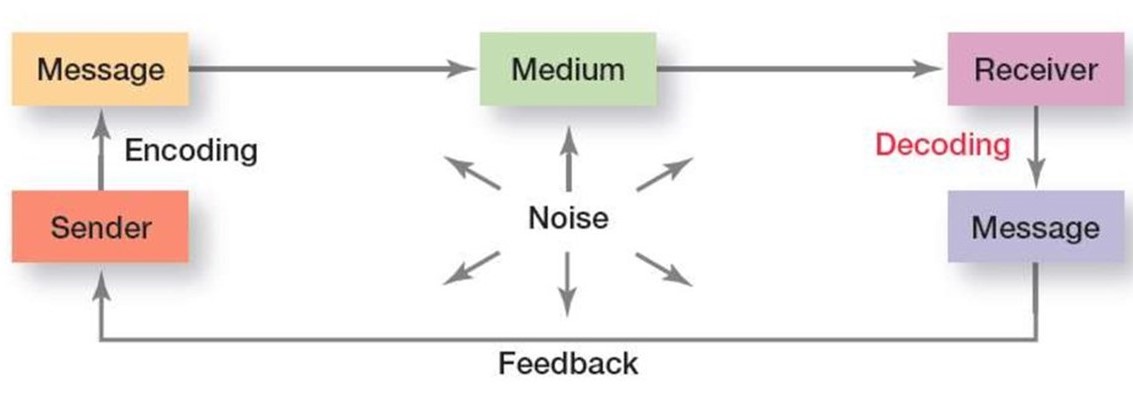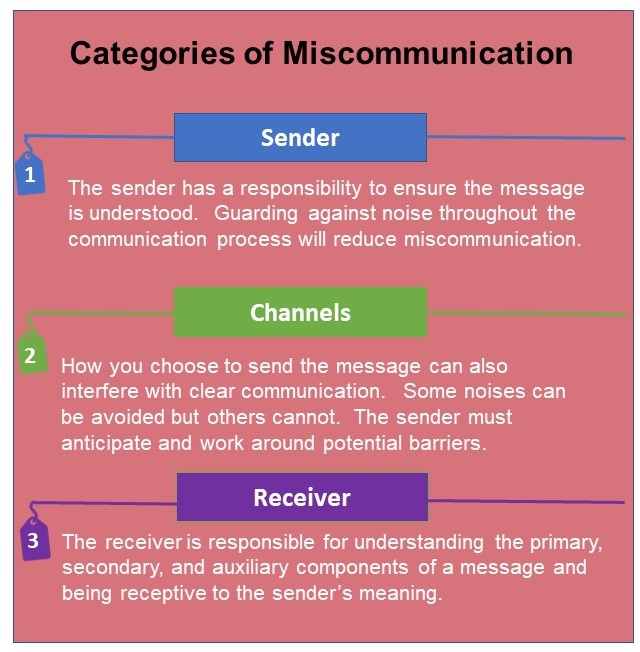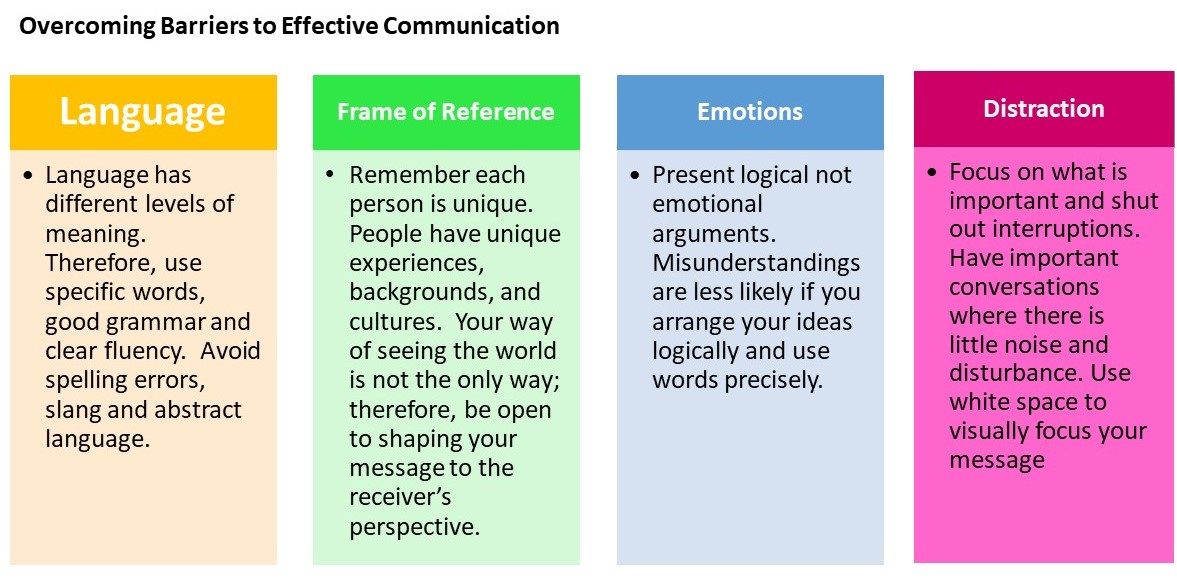Unit 3: Troubleshooting Miscommunication
Learning Objectives
 After studying this unit, you will be able to
After studying this unit, you will be able to
-
-
- troubleshoot communication errors by breaking down the communication process into its component parts
-
Introduction
Now with a basic overview of the communication process, troubleshooting miscommunication barriers becomes a matter of locating where in the communication process lies the problem: with the sender and the message they put together, the receiver and their feedback message, or the channel in the context of the environment between them. Identifying the culprit can help avoid costly business errors. According to Susan Washburn, communication problems can lead to:
- Conflict, damaged relationships, and animosity within an office and lost business with clients
- Productivity lost and resources wasted fixing problems that could have been avoided with proper communication
- Inefficiency in taking much longer to do tasks easily completed with better communication, leading to delays and missed deadlines
- Missed opportunities
- Unmet objectives due to unclear or shifting requirements or expectations
Let’s examine some of these in the real and imaged scenarios below.
If the receiver of the above “I’m hungry” message responded with something like “Yes, and I’m Romania,” to the sender the receiver would appear for a moment to have misunderstood the message as it was intended, though indeed the receiver did but chose to respond in a way that plays with the unintended possible misinterpretation of “hungry” as the homophone (a word that sounds the same as another completely different word) “Hungary,” a European country next to Romania. Part of the beauty and fun of language is that words—especially spoken ones—can have multiple meanings, which means that senders must be careful to anticipate potential misinterpretations of their messages due to carelessness towards ambiguities. In any case, once the joke is understood, the first sender can rest assured that the feedback message still confirms that the first message was understood, which is the end goal of communication.
Most jokes are harmless, but when breakdowns happen unintentionally in professional situations where opportunities, money, and reputations are on the line, these serious consequences make communication breakdowns no laughing matter. Take, for instance, the misplaced comma that cost Rogers Communications $1 million in a contract dispute over New Brunswick telephone poles (Austen, 2006) or the absence of an Oxford comma that cost Oakhurst Dairy $5 million in a Maine labour dispute (Associated Press, 2017). In both cases, everyone involved would have preferred to continue with business as usual rather. To avoid costly miscommunication in any business or organization, senders and receivers must be diligent in fulfilling their communication responsibilities and be wary of potential misunderstandings throughout the communication cycle.
Communication Barriers
The communication process may seem simple, but it is not. There are many barriers and distractions that can inhibit clear communication between sender and receiver. How many times have you thought you communicated an idea clearly only to later understand that you were completely misunderstood. Anything that interferes with clear communication is called Noise. Clear communication can be improved by learning to recognize the noises, or barriers to clear communication, that disrupt the various steps in the communication process.
Noise in the Communication Process

Some of the most significant noises are discussed in more detail after this short video presentation of 10 Barriers to Effective Communication.
Significant Communication Barriers
Bypassing: Different words have different meanings to different people. Bypassing happens when two people attached different meanings to the same word. For communication to be successful, the sender and receiver must attached the same meaning to the words, gestures, and symbols used to compose a message. Therefore, using concrete words and commonly understood symbols and gestures will decrease the chances of miscommunication.
Frame of Reference: Everyone experiences the world through a unique perspective based on individual experiences, backgrounds, culture, personality and many other factors. Thus, no two people experience the world exactly the same. To ensure communication is clear, the sender must be aware of his/her own frame of reference and the receiver’s frame of reference to achieve clear communication. For example, the frame of reference between baby-boomers and millennials is quite different. Therefore, inter-generational communication in the workplace can lead to miscommunication if sender and receiver do not account for the differing frames of reference.
Language Skills: No matter how great the message, it will not be understood or fully appreciated if the the appropriate oral and written skills are not used to express the message. Spelling, grammar, sentence structure, and fluency errors all interfere with clear communication. In addition, using jargon, slang, and unfamiliar words will also decrease clear communication.
Distractions: Emotional interference, physical distractions, and digital interruptions will also decrease clear communication. Shaping an objective message is difficult when on is feeling joy, fear, resentment, hostility, sadness or some other strong emotion. Physical distractions, such as faulty acoustics; sloppy appearance and careless formatting; as well as multi-tasking, information overload, conflicting demands can all interfere with clear communication. Focusing on what is important and shutting out interruptions increase the chances of effective communication.
Categories of Miscommunication
Sender-related Miscommunication
The responsibility of the sender of a message is to make it as easy as possible to understand the intended meaning. If work must be done to get your point across, it is on you as the sender to do all you can to make that happen. (The receiver also has their responsibilities that we’ll examine below, but listening and reading are not necessarily as labour-intensive as composing a message in either speech or writing.) This is why grammar, punctuation, and even document design in written materials, as well as excellent conversational and presentation skills, are so important: sender errors in these aspects of communication lead to readers’ and audiences’ confusion and frustration, which get in the way of their understanding the meaning you intended. If senders of messages fail to anticipate their audience’s needs and miss the target of writing or saying the right thing in the right way to get their messages across, they bear the responsibility for miscommunication and need to pay close attention to the lessons throughout this textbook to help them get back on target.
If the sender has any doubt that their message is being understood, it’s also on them to check in to make sure. If you are giving a presentation, for instance, you can employ several techniques to help ensure that your audience stays with you:
- Ensure that they can properly hear you by projecting your voice so that even the people in the back row can hear you properly; check that they can by asking if they can hear you just fine.
- Get them involved and engaged by asking for a show of hands on a topical question.
- Ask them to ask questions if they don’t understand anything; make them feel at ease to ask questions by saying that there are no stupid questions and that if a question occurs to any one of them, it is probably also occurring to the rest.
- Flag important points and, several minutes later, ask them to summarize them back to you when you are relating them to another major point.
Channel-related Miscommunication
Errors can also be blamed on the medium of the message such as the technology and the environment—some of which can slide back to choices the sender makes, but others are out of anyone’s control. If you need to work out the terms of a sale with a supplier a few towns over before you draw up the invoice and time is of the essence, sending an email and expecting a quick response would be foolish when you (a) have no idea if anyone’s there to write back right away, and (b) would potentially need to go back and forth over the terms; this exchange could potentially take days, but you only have an hour. The smart move is instead to phone the supplier so that you can have a quick conversation. If you need to, you could also text them to say that you’re calling to hammer out the details before writing it up. Of course, you wouldn’t call using a cellphone from inside a parking garage because blame for problems with the reception (or interference) would slide back on you for not positioning yourself appropriately given the available environments. If phone lines and the internet are down due to equipment malfunction (despite paying your bills and buying trustworthy equipment), however rare that might be, the problem is obviously out of your hands and in the environment. Otherwise, it’s entirely up to you to use the right channels the correct way in the environments best suited to clear communication to get the job done.
Receiver-related Miscommunication
The responsibility of the receiver of a message is to be able to actively read or hear not only the message itself, but also to understand the nuances of that message in context. Say you were a relatively recent hire at a company and were in line for a promotion for the excellent work you’ve been doing lately, it’s 11:45am, you just crossed paths with your manager in the hallway, and she’s the one who said “I’m hungry” (to use our example from above). That statement is the primary message, which simply describes how the speaker feels. But if she says it in a manner that, with nonverbals (or secondary messages) such as eyebrows raised signalling interest in your response and a flick of the head towards the exit, suggests an invitation to join her for lunch, you would be foolish not to put all of these contextual cues together and see this as a professional opportunity worth pursuing. If you responded with “Enjoy your lunch!” your manager would probably question your social intelligence and whether you would be able to capitalize on opportunities with clients when cues lined up for business opportunities that would benefit your company. But if you replied, “I’m starving, too. May I join you for lunch? I know a great place around the corner,” you would be correctly interpreting auxiliary messages such as your manager’s intention to assess your professionalism outside of the traditional office environment.

Say you arrive at the lunch spot with your manager and sit down to eat, but it’s too noisy to hear each other well; you would be equally foolish to use this environmental problem as an excuse not to talk and instead just browse your social media accounts on your phone (perhaps your usual lunchtime routine when eating solo) in front of her. You could accommodate her need to hear you by raising your voice, but the image of you shouting at your manager also sends all the wrong messages. Rather, if you cite the competing noise as a reason to move to a quieter spot where you can converse with her in a way that displays the polish of your manners and ultimately positions you nicely for the promotion, she would understand that you have the social intelligence to control the environmental conditions in ways that prioritize effective communication.
Of course, so much more can go wrong with the receiver. In general, the receiver may lack the knowledge to understand your message; if this is because you failed to accommodate their situation—say you used formal language and big, fancy words but they don’t understand because they are EAL (English as an additional language)—then the responsibility shifts back to you because you can do something about it. You could instead use more plain, easy-to-understand language. If your audience is a co-worker who should know what you’re talking about when you use the jargon of your profession, but they don’t because they’re in the wrong position, the problem is with the receiver (and perhaps the hiring process).
Another receiver problem may have to do with attitude. If a student, for instance, believes that they don’t really need to take a class in Communications because they’ve been speaking English for 19 years, think their high school English classes were a complete joke, and figure they’ll do just fine working out how to communicate in the workplace on their own, then the problem with this receiver is that overconfidence prevents them from keeping the open mind necessary to learn and take direction. Carried into the workplace, such arrogance would prevent them from actively listening to customers and managers, and they would most likely fail until they develop necessary active listening skills (see below). Employers like employees who can solve problems on their own, but not those who are unable to take direction.
Overcoming Barriers
Understanding the nature of communication can help you overcome the many barriers that can interfere with clear communication. Recognizing that the communication process is noise sensitive will help you anticipate the potential noises that can cause miscommunication. Figure 3.2 provides strategies to help you overcome four different categories of noise.

The picture emerging here, then, is one where many factors must work in concert to achieve communication of intended meaning. The responsibility of reaching the goal of understanding in the communication process requires the full cooperation of both the sender and receiver of a message to make the right choices and avoid all the perils—personal and situational—that lead to costly miscommunication.
Key Takeaway
 Being an effective professional involves knowing how to avoid miscommunication by upholding one’s responsibilities in the communication process towards the goal of ensuring proper understanding.
Being an effective professional involves knowing how to avoid miscommunication by upholding one’s responsibilities in the communication process towards the goal of ensuring proper understanding.
Exercise
 Describe a major miscommunication that you were involved in lately and its consequences. Was the problem with the sender, channel, environment, receiver, or a combination of these?
Describe a major miscommunication that you were involved in lately and its consequences. Was the problem with the sender, channel, environment, receiver, or a combination of these?
Explain what you did about it and what you would do (or advise someone else to do) to avoid the problem in the future.
References
Associated Press. (2017, March 21). Lack of comma, sense, ignites debate after $10m US court ruling. CBC News | Business. Retrieved from http://www.cbc.ca/news/business/comma-lawsuit-dairy-truckers-1.4034234
Austen, I. (2006, October 25). The comma that costs 1 million dollars (Canadian). The New York Times. Retrieved from http://www.nytimes.com/2006/10/25/business/worldbusiness/25comma.html
Washburn, S. (2008, February). The miscommunication gap. ESI Horizons, 9(2). Retrieved from http://www.esi-intl.com/public/Library/html/200802HorizonsArticle1.asp?UnityID=8522516.1290
Using too much text or adding too much graphic design elements on a page.
Studies have found that people who combine texting, video, phone, and other activities perform tasks significantly worse than non-multitaskers.
When a channel carries too many messages for the receiver to absorb or when too many messages are transmitted at the same time for the receiver to handle.

